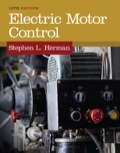
Electric Motor Control
10th Edition
ISBN: 9781305177611
Author: Herman
Publisher: Cengage
expand_more
expand_more
format_list_bulleted
Concept explainers
Textbook Question
Chapter 23, Problem 2SQ
In Part (A) of Figure 23–3, what will happen if both the run and jog push buttons are closed?
Expert Solution & Answer
Want to see the full answer?
Check out a sample textbook solution
Students have asked these similar questions
Consider the following transformer circuit assuming an ideal transformer. In this circuit
the signal generator will provide a 10-Volt peak-to-peak sinusoidal signal at a frequency
of 1.0 kHz. Assume that L₁ = 0.65 H, L2 = 0.00492 H (=4.92 mH) and that the coupling
constant = 0.99925.
+
VG1(
R1 1k
N1:N2
11.5:1
12
V1 N1
N2
V2
R2 8.2
1) Find the following using the theory presented in the prelab reading:
a) Start with Equations (2) of the prelab reading and show that the input impedance
to an ideal transformer is given by the equation for Z1 (=V1/11) in Equations (4) of
the prelab reading.
Equations (2) are: V₁ = joLI₁ + jœMI₂ and V₂ = j@MI₁ +j@L₂I₂
The equation for the input impedance is: Z₁ = 1½ = jwL₁ +
(WM)²
jwL₂+ZL
b) Assuming that Z is a real impedance, find the equations for the real and
imaginary parts of Z1.
c) Use your equations from part (b) to calculate the value of the input impedance
(Z) at an operating frequency of 200 Hz. Assume that the load impedance is 8.2
Ohms…
Use: R1 = 1.5K, R2 = 5K, R3 = 1K, R4 = 2K, R5 = 2K, R6 = 1K.
40%: Find the value for Vs (in V) such as IR2 = 1mA.
40%: Find the voltage VD.
20%: simulate the circuit in Falstad (attach the link).
A
1,5k
B
R1
Vs
L
5k
P2
R2
R6
E
C
R3
С
IR2= 1mA
D
H4
R4
2k
2k
R5
The joint pdf of random variables X=1, 2 and Y=1,2,3 is
Y
P(X,Y)= X [0.105
0.2
0.15]
0.151
0.18
Knowledge Booster
Learn more about
Need a deep-dive on the concept behind this application? Look no further. Learn more about this topic, electrical-engineering and related others by exploring similar questions and additional content below.Similar questions
- Find the eigenvalues and the corresponding eigen vectors of the following matrix: -5 A = [ 21 -7 4]arrow_forward+ 2) Acircuit is given as shown. (a) Find and label the circuit nodes (6) Determine voltages V₁, V2, V3 and Vy 4V C/E 노동 + 051 V4 + C/E + 3V- + /E5V 1 av + C E uk لا + V3C/E CIE + E6V -arrow_forwardConsider the following transformer circuit assuming an ideal transformer. In this circuit the signal generator will provide a 10-Volt peak-to-peak sinusoidal signal at a frequency of 1.0 kHz. Assume that L₁ = 0.65 H, L2 = 0.00492 H (=4.92 mH) and that the coupling constant = 0.99925. + VG1( R1 1k N1:N2 11.5:1 12 V1 N1 N2 V2 R2 8.2 1) Find the following using the theory presented in the prelab reading: a) Start with Equations (2) of the prelab reading and show that the input impedance to an ideal transformer is given by the equation for Z1 (=V1/11) in Equations (4) of the prelab reading. Equations (2) are: V₁ = joLI₁ + jœMI₂ and V₂ = j@MI₁ +j@L₂I₂ The equation for the input impedance is: Z₁ = 1½ = jwL₁ + (WM)² jwL₂+ZL b) Assuming that Z is a real impedance, find the equations for the real and imaginary parts of Z1. c) Use your equations from part (b) to calculate the value of the input impedance (Z) at an operating frequency of 200 Hz. Assume that the load impedance is 8.2 Ohms…arrow_forward
- HANDWRITTEN SOLUTION PLEASE NOT USING AIarrow_forwardFor the network of Fig. 7.93, determine: a. ID, and VGS₂- 18 V b. Vps and Vs. Shockley's equation, VGS ID= Vp) ID Vos V 1- VIDSS VGSQ VG = R₂VDD R₁ + R2 VGS VG-IDRS VDS VDD-ID(RD + Rs) (a) ID = 9 mA, VGS₁ = 0.5 V (b) VDs = 7.69 V, Vs = -0.5 V • 2.2 ΚΩ Dss = 8 mA Vp=-8V • 0.39 ΚΩ 8-4 V FIG. 7.93arrow_forwardHANDWRITTEN SOLUTION NOT USING AIarrow_forward
- Find the Eigenvalues and the corresponding Eigenvectors. 4 = [3³/2 0] =b A ยarrow_forward- Find Eigenvalues and Eigenvectors for the following matrices: A = 12arrow_forward4-9 A separate excited dc generator turning at 1400 r/min produces an induced voltage of 127 V. The armature resistance is 2 and the machine delivers a current of 12 A. Calculate a. the terminal voltage [V] b. the heat dissipated in the armature [W] c. the braking torque exerted by the armature [N-m]arrow_forward
- 1. Label the x, y, z coordinates for each frame. 2. Compute the homogeneous transformation matrices H between frames 0, 1, 2, and end- effector. 3. Use your MATLAB function to compute H°3. 01 d₁ d 02 d3arrow_forward4-8 Explain the difference between shunt, com- pound, and differential compound generators a. as to construction b. as to electrical propertiesarrow_forwardFor the following circuit bellow, given VS is 1.3 V. What is the value of VL? Is it possible to determine the vlaues of RS or RL. If so what are their values.arrow_forward
arrow_back_ios
SEE MORE QUESTIONS
arrow_forward_ios
Recommended textbooks for you

 Electricity for Refrigeration, Heating, and Air C...Mechanical EngineeringISBN:9781337399128Author:Russell E. SmithPublisher:Cengage Learning
Electricity for Refrigeration, Heating, and Air C...Mechanical EngineeringISBN:9781337399128Author:Russell E. SmithPublisher:Cengage Learning


Electricity for Refrigeration, Heating, and Air C...
Mechanical Engineering
ISBN:9781337399128
Author:Russell E. Smith
Publisher:Cengage Learning
Latches and Flip-Flops 1 - The SR Latch; Author: Computer Science;https://www.youtube.com/watch?v=-aQH0ybMd3U;License: Standard Youtube License